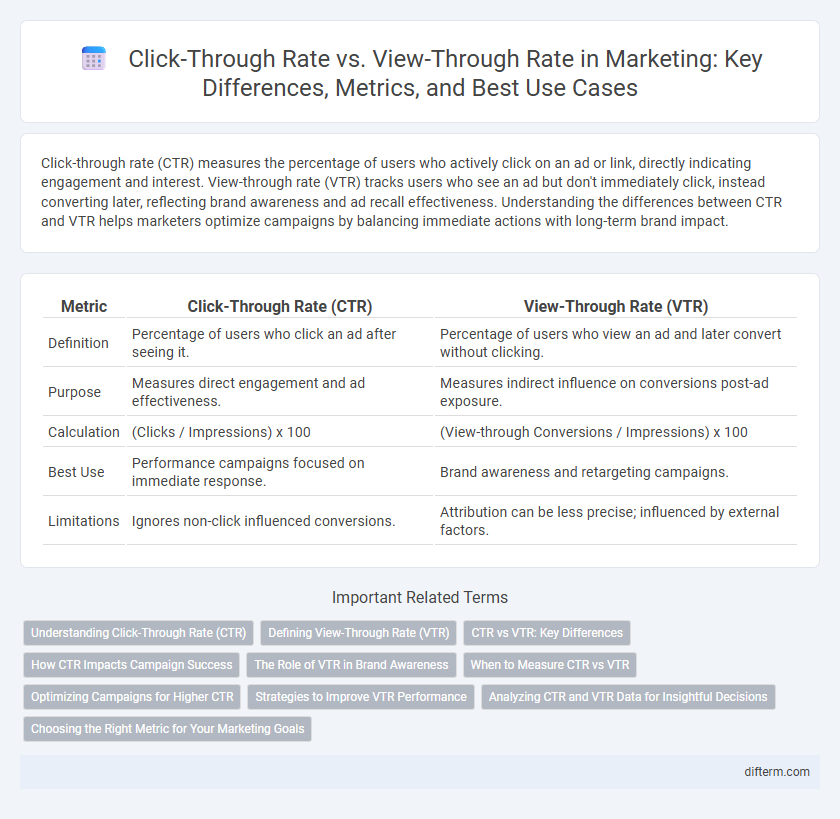Click-through rate (CTR) measures the percentage of users who actively click on an ad or link, directly indicating engagement and interest. View-through rate (VTR) tracks users who see an ad but don't immediately click, instead converting later, reflecting brand awareness and ad recall effectiveness. Understanding the differences between CTR and VTR helps marketers optimize campaigns by balancing immediate actions with long-term brand impact.
Table of Comparison
| Metric | Click-Through Rate (CTR) | View-Through Rate (VTR) |
|---|---|---|
| Definition | Percentage of users who click an ad after seeing it. | Percentage of users who view an ad and later convert without clicking. |
| Purpose | Measures direct engagement and ad effectiveness. | Measures indirect influence on conversions post-ad exposure. |
| Calculation | (Clicks / Impressions) x 100 | (View-through Conversions / Impressions) x 100 |
| Best Use | Performance campaigns focused on immediate response. | Brand awareness and retargeting campaigns. |
| Limitations | Ignores non-click influenced conversions. | Attribution can be less precise; influenced by external factors. |
Understanding Click-Through Rate (CTR)
Click-Through Rate (CTR) measures the percentage of users who click on an ad after viewing it, serving as a critical indicator of ad engagement and effectiveness. A high CTR suggests that the ad content, design, and call-to-action resonate well with the target audience, directly impacting conversion rates and campaign ROI. Marketers optimize CTR by refining ad relevance, targeting, and creative elements to maximize user interaction and drive quality traffic to landing pages.
Defining View-Through Rate (VTR)
View-Through Rate (VTR) measures the percentage of users who view an ad but do not click immediately, instead later taking a conversion action such as making a purchase or signing up. VTR captures the indirect impact of ad impressions on user behavior, providing insights into brand awareness and the effectiveness of display campaigns. This metric complements Click-Through Rate (CTR) by highlighting the delayed influence of visual exposure on consumer decisions.
CTR vs VTR: Key Differences
Click-Through Rate (CTR) measures the percentage of users who actively click on an ad to visit the advertiser's site, indicating direct engagement. View-Through Rate (VTR) tracks the percentage of users who view an ad but do not click immediately, yet later convert or visit the site, reflecting passive engagement and brand recall. CTR offers insights into immediate ad effectiveness, while VTR provides a broader understanding of ad influence over time.
How CTR Impacts Campaign Success
Click-Through Rate (CTR) directly measures the effectiveness of ad creatives and targeting by indicating the percentage of users who actively engage by clicking on ads. Higher CTRs often correlate with increased website traffic, better conversion opportunities, and improved return on investment (ROI) for marketing campaigns. While View-Through Rate (VTR) captures the passive ad exposure, a strong CTR more reliably drives immediate user actions, making it a critical metric for optimizing digital advertising performance.
The Role of VTR in Brand Awareness
View-Through Rate (VTR) plays a critical role in brand awareness by measuring the percentage of users who view a video ad but do not click immediately, yet later engage with the brand. VTR captures delayed consumer interactions that Click-Through Rate (CTR) often misses, offering deeper insight into ad recall and brand consideration. Marketers leverage VTR data to optimize video campaigns and enhance long-term brand recognition beyond immediate clicks.
When to Measure CTR vs VTR
Click-Through Rate (CTR) is most effective for measuring the immediate engagement of digital ads, especially in campaigns aiming for direct response or conversions. View-Through Rate (VTR) is ideal for assessing brand awareness and the influence of display or video ads where users may not click instantly but convert later. Marketers should measure CTR for performance-driven campaigns and VTR to evaluate the overall impact of impression-based advertising efforts.
Optimizing Campaigns for Higher CTR
Click-Through Rate (CTR) measures the percentage of users who click on an ad after seeing it, offering direct insight into ad engagement, while View-Through Rate (VTR) tracks conversions from users who saw but did not immediately click the ad. Optimizing campaigns for higher CTR involves refining ad copy, targeting more relevant audiences, and designing compelling call-to-actions to capture immediate interest. Prioritizing CTR improvements enhances measurable interactions, driving increased website traffic and more accurate ROI assessments.
Strategies to Improve VTR Performance
Improving View-Through Rate (VTR) performance requires targeting highly relevant audiences using contextual and behavioral data to increase ad engagement even without immediate clicks. Implementing sequential messaging and creative retargeting enhances brand recall and encourages users to view subsequent ads more attentively. Leveraging cross-channel attribution and optimizing ad frequency prevent ad fatigue, sustaining consistent viewer interest and raising overall VTR effectiveness.
Analyzing CTR and VTR Data for Insightful Decisions
Analyzing Click-Through Rate (CTR) and View-Through Rate (VTR) data reveals user engagement nuances by measuring direct clicks versus post-impression actions. CTR indicates immediate ad effectiveness through clicks, while VTR captures delayed conversions driven by ad visibility without direct interaction. Combining both metrics enables marketers to optimize campaigns by understanding both immediate response and brand impact over time.
Choosing the Right Metric for Your Marketing Goals
Click-Through Rate (CTR) measures the percentage of users who click on an ad after seeing it, making it ideal for campaigns focused on immediate engagement and conversions. View-Through Rate (VTR) tracks users who see an ad but engage later, providing insight into brand awareness and the impact of display ads. Selecting the right metric depends on whether the marketing goal prioritizes direct response or long-term brand influence.
Click-Through Rate vs View-Through Rate Infographic

 difterm.com
difterm.com